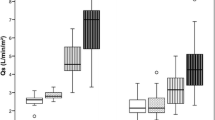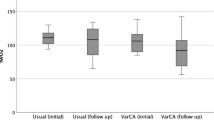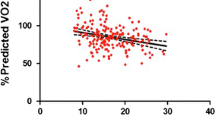Abstract
This study evaluated resting pulmonary function and its impact on exercise capacity after atrial baffle (BAFFLE) and arterial switch (SWITCH) repair of D-transposition of the great vessels (DTGV). Previously decreased exercise capacity in DTGV patients has been primarily attributed to cardiovascular limitations, whereas pulmonary limitations have largely been overlooked. Resting flow volume loops were compared for BAFFLE (n = 34) and SWITCH (n = 32) patients. Peak exercise variables were compared for BAFFLE (n = 30) and SWITCH (n = 25). Lung disease (restrictive and/or obstructive) was present in 53% of DTGV patients (BAFFLE 62% and SWITCH 44%; p = 0.14). BAFFLE patients had a normal breathing reserve, whereas that of SWITCH patients was decreased (27.3 ± 28.3 vs. 13.0 ± 19.2; p = 0.04). BAFFLE patients attained a lower percent of predicted peak oxygen pulse (82.7 ± 20.5% vs. 94.7 ± 19.3%; p = 0.04) and peak oxygen consumption (VO2peak) (26.6 ± 6.7 ml/kg/min vs. 37.3 ± 8.5 ml/kg/min; p < 0.01) than SWITCH patients. Patients after surgical repair for DTGV have an underappreciated occurrence of lung disease, even post-SWITCH. SWITCH patients have diminished breathing reserves, suggesting a pulmonary limitation to VO2peak. BAFFLE patients have lower VO2peaks, greater breathing reserves, and lower oxygen pulses than SWITCH patients, suggesting a cardiac limitation to peak aerobic capacity with probable secondary pulmonary limitations. Treating underlying lung disease in symptomatic patients after repair of DTGV may improve functional status.


Similar content being viewed by others

References
Balinotti JE, Tiller CJ, Llapur CJ, Jones MH, Kimmel RN, Coates CE et al (2009) Growth of the lung parenchyma early in life. Am J Respir Crit Care Med 179:134–137
Center for Disease Control (2007) Center for disease control’s summary healthy statistics for US adults. National health interview survey. Center for Disease Control, Atlanta, GA
de Koning WB, van Osch-Gevers M, Ten Harkel AD, van Domburg RT, Spijkerboer AW, Utens EM et al (2008) Follow-up outcomes 10 years after arterial switch operation for transposition of the great arteries: comparison of cardiological health status and health-related quality of life to those of the a normal reference population. Eur J Pediatr 167:995–1004
Dempsey JA, Miller JD, Romer LM (2006) ACSM’s advanced exercise physiology: the respiratory system. Lippincott Williams & Wilkins, Baltimore, MD, pp 246–299
Dockery DW (1993) Percentile curves for evaluation of repeated measures of lung function. Occup Med 8:323–338
Eigen H, Bieler H, Grant D, Christoph K, Terrill D, Heilman DK et al (2001) Spirometric pulmonary function in healthy preschool children. Am J Respir Crit Care Med 163:619–623
Fredriksen PM, Pettersen E, Thaulow E (2009) Declining aerobic capacity of patients with arterial and atrial switch procedures. Pediatr Cardiol 30:166–171
Freedson PS, Goodman T (1993) Pediatric laboratory exercise testing: measurement of oxygen consumption. Human Kinetics, Springfield, MA, pp 91–108
Giardini A, Khambadkone S, Rizzo N, Riley G, Napoleone CP, Muthialu N et al (2009) Determinants of exercise capacity after arterial switch operation for transposition of the great arteries. Am J Cardiol 104:1007–1012
Gilljam T, Sixt R (1995) Lung function in relation to haemodynamic status after atrial redirection for transposition of the great arteries. Eur Heart J 16:1952–1959
Hechter SJ, Webb G, Fredriksen PM, Benson L, Merchant N, Freeman M et al (2001) Cardiopulmonary exercise performance in adult survivors of the Mustard procedure. Cardiol Young 11:407–414
Hruda J, Sulc J, Radvansky J, Hucin B, Samanek M (1997) Good exercise tolerance and impaired lung function after atrial repair of transposition. Eur J Cardiothorac Surg 12:184–189
Joshi VM, Carey A, Simpson P, Paridon SM (1997) Exercise performance following repair of hypoplastic left heart syndrome: a comparison with other types of Fontan patients. Pediatr Cardiol 18:357–360
Kidd L, Mustard WT (1966) Hemodynamic effects of a totally corrective procedure in transposition of the great vessels. Circulation 33:I28–I33
Kirklin JW, Barratt-Boyes BG (1993) Complete transposition of the great arteries. In: Cardiac surgery. Churchill Livingstone, White Plains, New York, pp 1383–1467
Mahle WT, McBride MG, Paridon SM (2001) Exercise performance after the arterial switch operation for D-transposition of the great arteries. Am J Cardiol 87:753–758
Mulla N, Simpson P, Sullivan NM, Paridon SM (1997) Determinants of aerobic capacity during exercise following complete repair of tetralogy of Fallot with a transannular patch. Pediatr Cardiol 18:350–356
Nery LE, Wasserman K, French W, Oren A, Davis JA (1983) Contrasting cardiovascular and respiratory responses to exercise in mitral valve and chronic obstructive pulmonary diseases. Chest 83:446–453
Paul O (1952) Disturbances of pulmonary function in rheumatic heart disease. Postgrad Med 12:557–562
Pianosi PT, Johnson JN, Turchetta A, Johnson BD (2009) Pulmonary function and ventilatory limitation to exercise in congenital heart disease. Congenit Heart Dis 4:2–11
Samanek M, Sulc J, Zapletal A (1989) Lung function in simple complete transposition after intracardiac repair. Int J Cardiol 24:13–17
Sulc J, Andrle V, Hruda J, Hucin B, Samanek M, Zapletal A (1998) Pulmonary function in children with atrial septal defect before and after heart surgery. Heart 80:484–488
Wasserman KSD, Hansen J, Stringer W, Whipp B (2004) Principles of exercise testing and interpretation: clinical applications, 4th edn. Lippincott Williams & Wilkins, Baltimore, MD, pp 77–129
Acknowledgments
The authors appreciate the generous financial support from the Susan B. Murphy Fund of the Riley Children’s Foundation, Indianapolis, IN, which made this research possible. This research was conducted at Riley Hospital for Children at Indiana University Medical Center.
Author information
Authors and Affiliations
Corresponding author
Rights and permissions
About this article
Cite this article
Sterrett, L.E., Ebenroth, E.S., Montgomery, G.S. et al. Pulmonary Limitation to Exercise After Repair of D-Transposition of the Great Vessels: Atrial Baffle Versus Arterial Switch. Pediatr Cardiol 32, 910–916 (2011). https://doi.org/10.1007/s00246-011-0013-x
Received:
Accepted:
Published:
Issue Date:
DOI: https://doi.org/10.1007/s00246-011-0013-x



